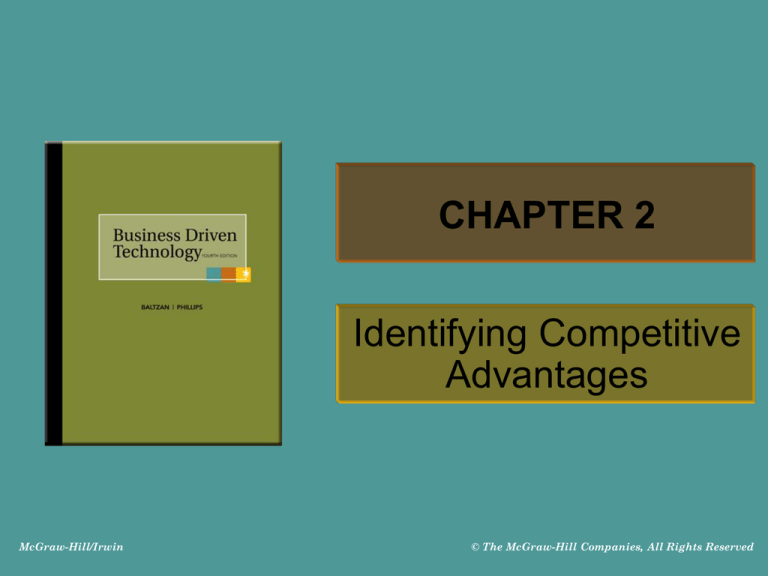
CHAPTER 2
Identifying Competitive
Advantages
McGraw-Hill/Irwin
© The McGraw-Hill Companies, All Rights Reserved
LEARNING OUTCOMES
2.1
Explain why competitive advantages are
typically temporary
2.2
List and describe each of the five forces in
Porter’s Five Forces Model
2.3
Compare Porter’s three generic strategies
2.4
Describe the relationship between business
processes and value chains
2-2
IDENTIFYING COMPETITIVE
ADVANTAGES
• To survive and thrive an organization
must create a competitive advantage
– Competitive advantage – a product or
service that an organization’s customers
place a greater value on than similar offerings
from a competitor
– First-mover advantage – occurs when an
organization can significantly impact its
market share by being first to market with a
competitive advantage
2-3
IDENTIFYING COMPETITIVE
ADVANTAGES
• Organizations watch their competition through
environmental scanning
– Environmental scanning – the acquisition and
analysis of events and trends in the environment
external to an organization
• Three common tools used in industry to analyze
and develop competitive advantages include:
– Porter’s Five Forces Model
– Porter’s three generic strategies
– Value chains
2-4
THE FIVE FORCES MODEL –
EVALUATING BUSINESS SEGMENTS
• Porter’s Five Forces Model determines the
relative attractiveness of an industry
2-5
Buyer Power
• Buyer power – assessed by analyzing
the ability of buyers to directly impact the
price they are willing to pay for an item
• Ways to reduce buyer power include
– Switching costs – costs that can make
customers reluctant to switch to another
product or service
– Loyalty program – rewards customers
based on the amount of business they do
with a particular organization
2-6
Supplier Power
• Supplier power – assessed by the suppliers’
ability to directly impact the price they are
charging for supplies (including materials,
labor, and services)
– Supply chain – consists of all parties involved in
the procurement of a product or raw material
2-7
Threat of Substitute Products or
Services
• Threat of substitute products or
services – high when there are many
alternatives to a product or service and
low when there are few alternatives from
which to choose
2-8
Threat of New Entrants
• Threat of new entrants – high when it is
easy for new competitors to enter a
market and low when there are significant
entry barriers to entering a market
– Entry barrier – a product or service feature
that customers have come to expect from
organizations in a particular industry and
must be offered by an entering organization
to compete and survive
2-9
Rivalry Among Existing Competitors
• Rivalry among existing competitors –
high when competition is fierce in a
market and low when competition is more
complacent
• Product differentiation – occurs when a company
develops unique differences in its products with the
intent to influence demand
• Although competition is always more
intense in some industries than in others,
the overall trend is toward increased
competition in just about every industry
2-10
Analyzing the Airline Industry
• Buyer power: high as customers have many
choices
• Supplier power: high as there are limited
plane and engine manufacturers to choose
from and unionized workforces squeeze the
airline’s profitability
• Threat of substitute products or services:
high as there are numerous transportation
alternatives
2-11
Analyzing the Airline Industry
• Threat of New Entrants: high as new
airlines are continuously entering the
market
• Rivalry among existing competitors:
high –for this reason airlines are forced to
compete on price
2-12
THE THREE GENERIC STRATEGIES –
CREATING A BUSINESS FOCUS
• Organizations typically follow one of
Porter’s three generic strategies when
entering a new market
2-13
THE THREE GENERIC STRATEGIES –
CREATING A BUSINESS FOCUS
2-14
Value Creation
• Once an organization chooses its
strategy, it can use tools such as the
value chain to determine the success or
failure of its chosen strategy
– Business process – a standardized set of
activities that accomplish a specific task, such
as processing a customer’s order
– Value chain – views an organization as a
series of processes, each of which adds
value to the product or service for each
customer
2-15
Value Creation
• Combining Porter’s Five Forces and three
generic strategies create business
strategies for each segment
2-16
Value Creation
• Value Chain
2-17
Value Creation
• Value chains with Porter’s Five Forces
2-18
OPENING CASE STUDY QUESTIONS
Apple – Merging Technology, Business, and
Entertainment
1. How can Apple use environmental
scanning to gain business intelligence?
2. Using Porter’s Five Forces Model,
analyze Apple’s buyer power and
supplier power
2-19
OPENING CASE STUDY QUESTIONS
Apple – Merging Technology, Business, and
Entertainment
3. Which of the three generic strategies is
Apple following?
4. Which of Porter’s Five Forces did Apple
address through the introduction of the
iPhone and customer developed iPhone
applications?
2-20
CHAPTER TWO CASE
BusinessWeek Interview with Michael Porter
• In an interview with BusinessWeek Senior
Writer Pete Engardio, Michael Porter explains
why he believes globalization has actually made
industry clusters and local advantages even
more important, rather than weakened them
2-21
CHAPTER TWO CASE QUESTIONS
1. In today’s global business environment,
does the physical location of a business
matter?
2. Why is collaboration among universities
important?
2-22
CHAPTER TWO CASE QUESTIONS
3. Is there a competitiveness problem in the United
States?
4. What are the big differences in the way
communities approach development today
compared to 1990, when Porter wrote The
Competitive Advantage of Nations?
2-23



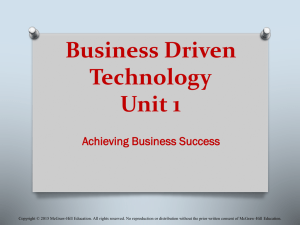
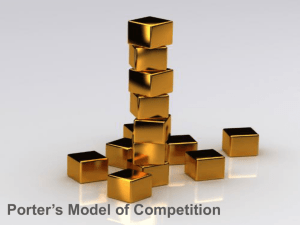
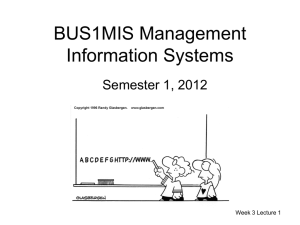
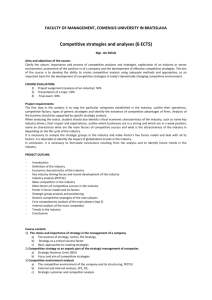
![[5] James William Porter The third member of the Kentucky trio was](http://s3.studylib.net/store/data/007720435_2-b7ae8b469a9e5e8e28988eb9f13b60e3-300x300.png)